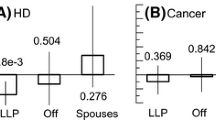Abstract
Although the ApoE gene has been intensively studied in aging research, most of the studies conducted so far have been based on the traditional case–control design with subjects consisting of young controls and long-lived cases. The genotype frequency pattern in and between the two age-groups has been rarely investigated due to limitations in either research design or data analytical method. In this study, we genotyped 748 individuals (including both twin pairs and unrelated individuals) aged from 73 to 95 with aim at examining the genotype frequency trajectory of ApoE gene at high ages. Binomial and multinomial logistic regression models have been applied to model the gene frequency as a function of age and to investigate the modes of gene function (dominant, recessive, additive). The generalized estimation equations (GEEs) are introduced to account for the intra-pair genotype correlation in the twin pairs included in the data. Both the observed and the fitted frequencies show a constantly declining pattern of ApoE ε4 allele as age advances indicating a significant and steadily deleterious effect of the dominant allele that increases the hazard of death at high ages.
Similar content being viewed by others
References
Kervinen K, Savolainen MJ, Salokannel J, et al. Apolipoprotein E and B polymorphisms-longevity factors assessed in nonagenarians. Atherosclerosis 1994; 105: 89–95.
Mahley RW, Huang Y. Apolipoprotein E: From atherosclerosis to Alzheimer's disease and beyond. Curr Opin Lipidol 1999; 10: 207–217.
Corder EH, Saunders AM, Strittmatter WJ, et al. Gene dose of apolipoprotein E type 4 allele and the risk of Alzheimer's disease in late onset families. Science 1993; 261(5123): 921–923.
Marshall E. The Alzheimer's gene puzzle. Science 1998; 280: 1002.
Schachter F, Faure-Delaneff L, Guenot F, et al. Genetic associations with human longevity at the APOE and ACE loci. Nat Gene 1994; 6: 29–32.
Zhang JG, Ma YX, Wang CF, et al. Apolipoprotein E and longevity among Chinese population. Mech Ageing Dev 1998; 104: 159–167.
Gerdes LU, Jeune B, Ranberg KA, Nybo H, Vaupel JW. Estimation of apolipoprotein E genotype-specific relative mortality risks from the distribution of genotypes in centenarians and middle-aged men: Apolipoprotein E gene is a 'frailty gene', not a 'longevity gene'. Genet Epidemiol 2000; 19: 202–210.
Bader G, Zuliani G, Kostner GM, Fellin R. Apolipoprotein E polymorphism is not associated with longevity or disability in a sample of Italian octoand nonagenarians. Gerontology 1998; 44: 293–299.
Rea IM, Mc Dowell I, McMaster D, Smye M, Stout R, Evans A. Apolipoprotein E alleles in nonagenarian subjects in the Belfast Elderly Longitudinal Free-living Ageing Study (BELFAST). Mech Ageing Dev 2001; 122(13): 1367–1372.
Blanche H, Cabanne L, Sahbatou M, Thomas G. A study of French centenarians: Are ACE and APOE associated with longevity? CR Acad Sci III 2002; 324(2): 129–135. 655
Smith JD. Apolipoproteins and aging: Emerging mechanisms. Ageing Res Rev 2002; 1: 345–365.
Tan Q, Yashin AI, De Benedictis G, et al. A logistic regression model for measuring gene-longevity associations. Clin Genet 2001; 60: 463–469.
Christensen K, Holm NV, McGue M, Corder L, Vaupel JW. A Danish population-based twin study on general health in the elderly. J Aging Health 1999; 11: 49–64.
Nybo H, Gaist D, Jeune B, et al. The Danish 1905 Cohort: A Genetic-Epidemiological Nationwide Survey. Age Ageing 2001; 13: 32–46.
Hixson JE, Vernier DT. Restriction isotyping of human apolipoprotein E by gene amplification and cleavage with HhaI. J Lipid Res 1990; 31: 545–548.
Hosmer DW, Lemeshow S. Applied logistic models. 2nd edn. USA: Wiley, 2000.
Tan Q, Bathum L, Christiansen L, et al. Logistic regression models for polymorphic and antagonistic pleiotropic gene action on human aging and longevity. Ann Hum Genet 2003; 67: 598–607.
Van Bockxmeer FM. ApoE and ACE genes: Impact on human longevity. Nat Gene 1994; 6: 4–5.
Yashin AI, De Benedictis G, Vaupel JW, et al. Genes, demography, and life span: The contribution of demographic data in genetic studies on aging and longevity. Am J Hum Genet 1999; 65: 1178–1193.
Tan Q, De Benedictis G, Yashin AI, et al. Measuring the genetic influence in modulating human life span: Gene-environment and gene-sex interactions. Biogerontology 2001; 2: 141–153.
Tan Q, Yashin AI, Bladbjerg EM, et al. Variations of cardiovascular disease associated genes exhibit sexdependent influence on human longevity. Exp Gerontol 2001; 36: 1303–1315.
Li H. The additive genetic gamma frailty model for linkage analysis of age-of-onset variation. Ann Hum Genet 1999; 63: 455–468.
Li H, Hsu L. Effects of age at onset on the power of the affected sib pair and transmission/disequilibrium tests. Ann Hum Genet 2000; 64: 239–254.
Hsu L, Li H, Houwing-Duistermaat JJ. A method for incorporating ages at onset in affected sibpair linkage studies. Hum Hered 2002; 54: 1–12.
Thomas DC, Witte JS. Point: Population stratification: A problem for case-control studies of candidate-gene associations? Cancer Epidemiol Biomar Prev 2002; 11: 505–512.
Wacholder S, Rothman N, Caporaso N. Population stratification in epidemiologic studies of common genetic variants and cancer: Quantification of bias. J Natl Cancer Inst 2000; 92: 1151–1158.
Ewens WJ, Spielman RS. The transmission/disequilibrium test: History, subdivision, and admixture. Am J Hum Genet 1995; 57: 455–464.
Waldman ID, Robinson BF, Rowe DC. A logistic regression based extension of the TDT for continuous and categorical traits. Ann Hum Genet 1999; 63(Pt 4): 329–340.
Liang KY, Zeger SL. Longitudinal data analysis using generalised linear models. Biometrika 1986; 73: 13–22.
Zeger SL, Liang KY. Longitudinal data analysis for discrete and continuous outcomes. Biometrics 1986; 42: 121–130.
Author information
Authors and Affiliations
Corresponding author
Rights and permissions
About this article
Cite this article
Tan, Q., Christiansen, L., Christensen, K. et al. Apolipoprotein E Genotype Frequency Patterns in Aged Danes as Revealed by Logistic Regression Models. Eur J Epidemiol 19, 651–656 (2004). https://doi.org/10.1023/B:EJEP.0000036784.64143.26
Issue Date:
DOI: https://doi.org/10.1023/B:EJEP.0000036784.64143.26




